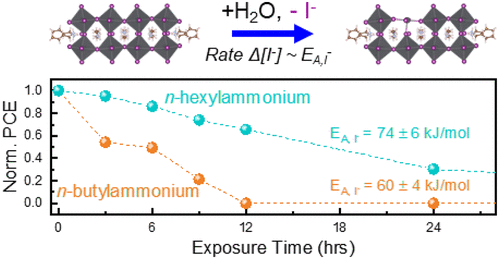当前位置:
X-MOL 学术
›
J. Phys. Chem. C
›
论文详情
Our official English website, www.x-mol.net, welcomes your
feedback! (Note: you will need to create a separate account there.)
Effects of Alkylammonium Choice on Stability and Performance of Quasi-2D Organolead Halide Perovskites
The Journal of Physical Chemistry C ( IF 3.3 ) Pub Date : 2020-04-30 , DOI: 10.1021/acs.jpcc.0c02822 Bryan R. Wygant , Alexandre Z. Ye , Andrei Dolocan , C. Buddie Mullins
The Journal of Physical Chemistry C ( IF 3.3 ) Pub Date : 2020-04-30 , DOI: 10.1021/acs.jpcc.0c02822 Bryan R. Wygant , Alexandre Z. Ye , Andrei Dolocan , C. Buddie Mullins

|
The long-term instability of typical organolead halide perovskites has led to increased interest in Ruddlesden–Popper phase (RPP) perovskites. These materials have been shown to possess high stability under a variety of conditions, including humidity, making them interesting candidates for stable perovskite devices. Here, we report the increased moisture stability of a methylammonium lead triiodide-based (MAPI) RPP perovskite containing n-hexylammonium (hexyl-MAPI) as compared to an otherwise-identical material synthesized using n-butylammonium (butyl-MAPI), attributed to decreased halide mobility within the material. Despite only small differences in chemical composition, hexyl-MAPI photovoltaic devices show a significantly lower performance loss compared to butyl-MAPI devices when exposed to 78% RH, using both Au and reactive Ag electrodes. We find evidence that both perovskites develop a passivation layer composed of low-n perovskite phases at the film surface following exposure to humidity, but only butyl-MAPI films exhibit clear spectroscopic evidence of distinct low-n phases. Analysis of full devices using time-of-flight secondary ion mass spectrometry provides additional evidence of the passivation layer and shows hexyl-MAPI leaches less iodide during moisture exposure. Halide mobility measurements further confirm this observation and show that the activation energy of halide mobility in n = 2 hexyl-MAPI (74± 6 kJ/mol) is larger than that in butyl-MAPI (60± 4 kJ/mol). Together, these results show that increasing the barrier to halide mobility in perovskite materials reduces the rate of iodide leaching and indicates that RPP perovskite phases could be used to increase the stability of perovskite photovoltaic devices, regardless of the metal contact.
中文翻译:

烷基铵的选择对准2D有机油卤化物钙钛矿稳定性和性能的影响
典型的有机铅卤化物钙钛矿的长期不稳定性导致人们对Ruddlesden-Popper相(RPP)钙钛矿的兴趣增加。这些材料已显示出在各种条件下(包括湿度)都具有很高的稳定性,这使其成为稳定钙钛矿设备的有趣候选材料。在这里,我们报告了与使用n合成的相同材料相比,含正己基铵(hexyl-MAPI)的基于甲基铵三碘化铅(MAPI)RPP钙钛矿的湿稳定性提高了-丁基铵(丁基-MAPI),归因于材料中卤化物的迁移率降低。尽管在化学成分上只有很小的差异,但是当使用Au和活性Ag电极同时暴露于78%RH时,与丁基MAPI器件相比,己基MAPI光伏器件表现出明显更低的性能损失。我们发现证据表明,钙钛矿开发低的构成的钝化层Ñ在暴露于湿度的薄膜表面钙钛矿相,但只有丁基MAPI膜表现出明显低的明确证据光谱Ñ阶段。使用飞行时间二次离子质谱仪对整个设备进行的分析提供了钝化层的其他证据,并显示出在潮湿环境中己基-MAPI浸出的碘化物更少。卤化物迁移率的测量进一步证实了这一观察结果,并表明在n = 2己基MAPI(74±6 kJ / mol)中,卤化物迁移率的活化能大于在丁基MAPI(60±4 kJ / mol)中的活化能。总之,这些结果表明,增加钙钛矿材料中卤化物迁移的势垒会降低碘化物的浸出速率,并表明RPP钙钛矿相可用于增加钙钛矿光伏器件的稳定性,而与金属接触无关。
更新日期:2020-04-30
中文翻译:

烷基铵的选择对准2D有机油卤化物钙钛矿稳定性和性能的影响
典型的有机铅卤化物钙钛矿的长期不稳定性导致人们对Ruddlesden-Popper相(RPP)钙钛矿的兴趣增加。这些材料已显示出在各种条件下(包括湿度)都具有很高的稳定性,这使其成为稳定钙钛矿设备的有趣候选材料。在这里,我们报告了与使用n合成的相同材料相比,含正己基铵(hexyl-MAPI)的基于甲基铵三碘化铅(MAPI)RPP钙钛矿的湿稳定性提高了-丁基铵(丁基-MAPI),归因于材料中卤化物的迁移率降低。尽管在化学成分上只有很小的差异,但是当使用Au和活性Ag电极同时暴露于78%RH时,与丁基MAPI器件相比,己基MAPI光伏器件表现出明显更低的性能损失。我们发现证据表明,钙钛矿开发低的构成的钝化层Ñ在暴露于湿度的薄膜表面钙钛矿相,但只有丁基MAPI膜表现出明显低的明确证据光谱Ñ阶段。使用飞行时间二次离子质谱仪对整个设备进行的分析提供了钝化层的其他证据,并显示出在潮湿环境中己基-MAPI浸出的碘化物更少。卤化物迁移率的测量进一步证实了这一观察结果,并表明在n = 2己基MAPI(74±6 kJ / mol)中,卤化物迁移率的活化能大于在丁基MAPI(60±4 kJ / mol)中的活化能。总之,这些结果表明,增加钙钛矿材料中卤化物迁移的势垒会降低碘化物的浸出速率,并表明RPP钙钛矿相可用于增加钙钛矿光伏器件的稳定性,而与金属接触无关。

































 京公网安备 11010802027423号
京公网安备 11010802027423号